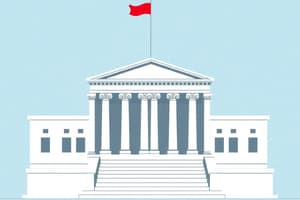Podcast
Questions and Answers
Which branch of government is responsible for interpreting laws and settling disputes between states or individuals and the federal government?
Which branch of government is responsible for interpreting laws and settling disputes between states or individuals and the federal government?
- Legislative Branch
- Executive Branch
- Judicial Branch (correct)
- None of the above
What is the primary function of the legislative branch, Congress?
What is the primary function of the legislative branch, Congress?
- Interpreting laws
- Appointing federal judges
- Enforcing laws
- Creating laws (correct)
How is the representation in the House of Representatives determined?
How is the representation in the House of Representatives determined?
- Based on the number of electors in the state
- Representation is equal across all states
- Based on the size of the state's population (correct)
- Each state has two representatives
What is the purpose of checks and balances in the U.S. government?
What is the purpose of checks and balances in the U.S. government?
Which of the following is NOT a power held by the president?
Which of the following is NOT a power held by the president?
What is the role of the Supreme Court?
What is the role of the Supreme Court?
What is the significance of the concept of judicial review?
What is the significance of the concept of judicial review?
What system of government is described as dividing power between a national government and state or local governments?
What system of government is described as dividing power between a national government and state or local governments?
Which of the following is NOT a guaranteed right outlined in the Bill of Rights?
Which of the following is NOT a guaranteed right outlined in the Bill of Rights?
Which branch of government is responsible for interpreting and applying the Bill of Rights?
Which branch of government is responsible for interpreting and applying the Bill of Rights?
Which of the following is a core principle of the American political system as outlined in the Constitution?
Which of the following is a core principle of the American political system as outlined in the Constitution?
How can the U.S. Constitution be amended?
How can the U.S. Constitution be amended?
Which of the following is NOT a key characteristic of the American political system?
Which of the following is NOT a key characteristic of the American political system?
Which of the following factors can influence voter turnout in elections?
Which of the following factors can influence voter turnout in elections?
What role do interest groups play in the American political process?
What role do interest groups play in the American political process?
How does the media influence public opinion?
How does the media influence public opinion?
Flashcards
Article V
Article V
The section of the Constitution detailing how amendments can be added.
Branches of Government
Branches of Government
The divisions of power in the U.S. government: legislative, executive, and judicial.
Bill of Rights
Bill of Rights
The first ten amendments to the Constitution that guarantee citizens' rights.
Legislative Branch
Legislative Branch
Signup and view all the flashcards
Civil Liberties
Civil Liberties
Signup and view all the flashcards
Executive Branch
Executive Branch
Signup and view all the flashcards
Elections
Elections
Signup and view all the flashcards
Judicial Branch
Judicial Branch
Signup and view all the flashcards
Campaign Finance Laws
Campaign Finance Laws
Signup and view all the flashcards
Congress Powers
Congress Powers
Signup and view all the flashcards
Political Participation
Political Participation
Signup and view all the flashcards
Federalism
Federalism
Signup and view all the flashcards
Judicial Review
Judicial Review
Signup and view all the flashcards
Checks and Balances
Checks and Balances
Signup and view all the flashcards
U.S. Constitution
U.S. Constitution
Signup and view all the flashcards
Amending the Constitution
Amending the Constitution
Signup and view all the flashcards
Study Notes
Branches of Government
- The U.S. government operates under a system of checks and balances, dividing power among three branches: legislative, executive, and judicial.
- The legislative branch, Congress, is responsible for creating laws. It consists of the Senate and the House of Representatives.
- The executive branch, headed by the President, enforces laws. This branch includes various federal agencies and departments.
- The judicial branch, headed by the Supreme Court, interprets laws. It also settles disputes between states or individuals and the federal government.
Legislative Branch
- Congress's primary function is lawmaking, but it also has other powers like declaring war, regulating commerce, and approving presidential appointments.
- The House of Representatives is based on population, with representation varying per state. The Senate has two senators per state, creating equal representation among states.
- Congress has enumerated powers, specifically listed in the Constitution.
Executive Branch
- The President is the head of the executive branch and commander-in-chief of the armed forces.
- The President appoints federal judges and other officials, as well as negotiates treaties.
- The President also has the power to veto legislation passed by Congress.
- Bureaucracy is a large part of the executive branch, made up of various federal agencies that carry out government policies. They are staffed by civil servants rather than politicians.
Judicial Branch
- The judicial branch's role is to interpret laws and apply them to specific cases.
- The Supreme Court is the highest court in the land and can overturn lower court decisions, as well as laws found to violate the Constitution.
- Federal judges serve for life, providing stability and independence.
- The concept of judicial review, established in Marbury v. Madison, allows the Supreme Court to review the constitutionality of laws passed by Congress and actions taken by the President.
Federalism
- Federalism is a system of government where power is divided between a national government and state or local governments.
- There is a debate over the balance of power between the federal and state governments.
- Enumerated powers belong to the federal government, while reserved powers are for the states. Some powers are concurrent, meaning both levels can exercise them.
Amending the Constitution
- The U.S. Constitution can be amended, meaning changes can be made to its wording.
- The process is outlined in Article V and generally requires a supermajority vote of Congress and ratification by the states.
- Amendments reflect changing societal values and priorities.
Civil Liberties and Rights
- The Bill of Rights guarantees fundamental rights and freedoms to citizens, limiting the power of the government.
- These rights include freedom of speech, religion, assembly, and the right to due process and equal protection under the law.
- The Supreme Court plays a crucial role in interpreting and applying these rights in different contexts.
Elections and Campaigns
- Elections are the foundation of American democracy, allowing citizens to choose their representatives.
- Candidates raise money for campaigns, often through various sources, and engage in campaigning to get elected.
- Campaign finance laws regulate the amount and source of money used in political campaigns.
Political Participation
- Various forms of political participation exist, from voting to contacting elected officials.
- Factors like education, income, and demographics can influence participation rates.
- Interest groups and political parties represent the interests of their members and try to influence policy decisions.
Public Opinion and Media
- Public opinion significantly influences policy decisions.
- The media plays a vital role in shaping public discourse and informing citizens.
- The connection between media and public opinion is complex and subject to debate and analysis.
Checks and Balances
- The system of checks and balances limits the power of each branch of government.
- Each branch has specific powers to limit the actions of the other branches.
- The system of checks and balances is essential for preventing tyranny and maintaining a balance of power.
The Constitution
- The U.S. Constitution outlines the basic framework of the government, including the powers of each branch and the rights of citizens.
- The Constitution provides a framework for the American political system.
- It is the foundation of the legal system and has inspired constitutional systems elsewhere.
Studying That Suits You
Use AI to generate personalized quizzes and flashcards to suit your learning preferences.




